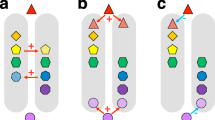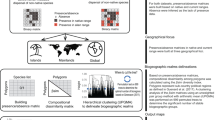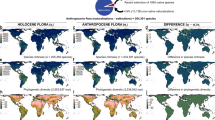Abstract
The redistribution of alien species across the globe accelerated with the start of European colonialism. European powers were responsible for the deliberate and accidental transportation, introduction and establishment of alien species throughout their occupied territories and the metropolitan state. Here, we show that these activities left a lasting imprint on the global distribution of alien plants. Specifically, we investigated how four European empires (British, Spanish, Portuguese and Dutch) structured current alien floras worldwide. We found that compositional similarity is higher than expected among regions that once were occupied by the same empire. Further, we provide strong evidence that floristic similarity between regions occupied by the same empire increases with the time a region was occupied. Network analysis suggests that historically more economically or strategically important regions have more similar alien floras across regions occupied by an empire. Overall, we find that European colonial history is still detectable in alien floras worldwide.
This is a preview of subscription content, access via your institution
Access options
Access Nature and 54 other Nature Portfolio journals
Get Nature+, our best-value online-access subscription
$29.99 / 30 days
cancel any time
Subscribe to this journal
Receive 12 digital issues and online access to articles
$119.00 per year
only $9.92 per issue
Buy this article
- Purchase on Springer Link
- Instant access to full article PDF
Prices may be subject to local taxes which are calculated during checkout



Similar content being viewed by others
Data availability
All driver datasets used in the study are openly available and provide spatially explicit, gridded information and the aggregated data are provided in Supplementary Table 5. The GloNAF database together with the shapefile that was used to produce the maps have been published in a data paper35. All data and code are available on Zenodo and can be found here: https://doi.org/10.5281/zenodo.6640264.
Code availability
All code is available on Zenodo and can be found here: https://doi.org/10.5281/zenodo.6640264.
References
Richardson, D. M. et al. Naturalization and invasion of alien plants: concepts and definitions. Divers. Distrib. 6, 93–107 (2000).
Winter, M. et al. Plant extinctions and introductions lead to phylogenetic and taxonomic homogenization of the European flora. Proc. Natl Acad. Sci. USA 106, 21721–21725 (2009).
Pyšek, P. et al. Naturalized alien flora of the world: species diversity, taxonomic and phylogenetic patterns, geographic distribution and global hotspots of plant invasion. Preslia 89, 203–274 (2017).
Daru, B. H. et al. Widespread homogenization of plant communities in the Anthropocene. Nat. Commun. 12, 6983 (2021).
Yang, Q. et al. The global loss of floristic uniqueness. Nat. Commun. 12, 7290 (2021).
van Kleunen, M. et al. Global exchange and accumulation of non-native plants. Nature 525, 100–103 (2015).
Dawson, W. et al. Global hotspots and correlates of alien species richness across taxonomic groups. Nat. Ecol. Evol. 1, 0186 (2017).
Essl, F. et al. Drivers of the relative richness of naturalized and invasive plant species on Earth. AoB Plants 11, plz051 (2019).
Pyšek, P. & Richardson, D. M. The biogeography of naturalization in alien plants. J. Biogeogr. 33, 2040–2050 (2006).
Moser, D. et al. Remoteness promotes biological invasions on islands worldwide. Proc. Natl Acad. Sci. USA 115, 9270–9275 (2018).
Guo, Q. et al. Latitudinal patterns of alien plant invasions. J. Biogeogr. 48, 253–262 (2021).
Pyšek, P. et al. Disentangling the role of environmental and human pressures on biological invasions across Europe. Proc. Natl Acad. Sci. USA 107, 12157–12162 (2010).
Essl, F. et al. Socioeconomic legacy yields an invasion debt. Proc. Natl Acad. Sci. USA 108, 203–207 (2011).
Helmus, M. R., Mahler, D. L. & Losos, J. B. Island biogeography of the Anthropocene. Nature 513, 543–546 (2014).
di Castri, F. in Biological Invasions: A Global Perspective (ed. Drake, J. et al.), Ch. 1 (Wiley, 1989).
Crosby, A. W. Ecological Imperialism: The Biological Expansion of Europe, 900–1900 2nd edn (Cambridge Univ. Press, 2004).
Diamond, J. M. Guns, Germs, and Steel: The Fates of Human Societies (Norton, 2005).
Nunn, N. & Qian, N. The Columbian exchange: a history of disease, food, and ideas. J. Econ. Perspect. 24, 163–188 (2010).
Beinart, W. & Middleton, K. Plant transfers in historical perspective: a review article. Environ. Hist. Camb. 10, 3–29 (2004).
Mrozowski, S. A. in Historical Archaeology (eds Hall, M. & Silliman, S. W.) Ch. 2 (Blackwell, 2006).
Brockway, L. H. Science and colonial expansion: the role of the British Royal Botanic Gardens. Am. Ethnol. 6, 449–465 (1979).
Hulme, P. E. Addressing the threat to biodiversity from botanic gardens. Trends Ecol. Evol. 26, 168–174 (2011).
Baas, P. The golden age of Dutch colonial botany and its impact on garden and herbarium collections. In Proc. Int. Symp. held by The Royal Danish Academy of Sciences and Letters in Copenhagen (eds Friis, I. & Balselv, H.), 53–62 (2017).
Anderson, W. Climates of opinion: acclimatization in nineteenth-century France and England. Vic. Stud. 35, 135–157 (1992).
Osborne, M. A. Acclimatizing the world: a history of the paradigmatic colonial science. Osiris 15, 135–151 (2000).
Musgrave, T., Gardner, C. & Musgrave, W. The Plant Hunters Two Hundred Years of Adventure and Discovery (Seven Dials, 1999).
Stoner, A. & Hummer, K. 19th and 20th century plant hunters. HortScience 42, 197–199 (2007).
Williams, K. A. An overview of the U.S. National Plant Germplasm System’s Exploration Program. HortScience 40, 297–301 (2005).
McCracken, D. P. Gardens of Empire: Botanical Institutions of the Victorian British Empire Garden History Vol. 26 (Leicester Univ. Press, 1997).
Mitchener, K. J. & Weidenmier, M. Trade and empire. Econ. J. 118, 1805–1834 (2008).
World Trade Report 2007: Six Decades of Multilateral Trade Cooperation: What Have We Learnt? (World Trade Organization, 2007).
Seebens, H. et al. No saturation in the accumulation of alien species worldwide. Nat. Commun. 8, 14435 (2017).
Seebens, H. et al. Global rise in emerging alien species results from increased accessibility of new source pools. Proc. Natl Acad. Sci. USA 115, E2264–E2273 (2018).
Essl, F. et al. Historical legacies accumulate to shape future biodiversity in an era of rapid global change. Divers. Distrib. 21, 534–547 (2015).
van Kleunen, M. et al. The Global Naturalized Alien Flora (GloNAF) database. Ecology 100, e02542 (2019).
Soininen, J., McDonald, R. & Hillebrand, H. The distance decay of similarity in ecological communities. Ecography 30, 3–12 (2007).
Blackburn, T. M. et al. A proposed unified framework for biological invasions. Trends Ecol. Evol. 26, 333–339 (2011).
Colautti, R. I., Grigorovich, I. A. & MacIsaac, H. J. Propagule pressure: a null model for biological invasions. Biol. Invasions 8, 1023–1037 (2006).
Cassey, P., Delean, S., Lockwood, J. L., Sadowski, J. S. & Blackburn, T. M. Dissecting the null model for biological invasions: a meta-analysis of the propagule pressure effect. PLoS Biol. 16, e2005987 (2018).
Blackburn, T. M., Cassey, P. & Duncan, R. P. Colonization pressure: a second null model for invasion biology. Biol. Invasions 22, 1221–1233 (2020).
Nekola, J. C. & White, P. S. The distance decay of similarity in biogeography and ecology. J. Biogeogr. 26, 867–878 (1999).
Liu, C., Wolter, C., Xian, W. & Jeschke, J. M. Most invasive species largely conserve their climatic niche. Proc. Natl Acad. Sci. USA 117, 23643–23651 (2020).
Panton, K. J. Historical Dictionary of the British Empire (Rowman & Littlefield, 2015).
Brendon, P. The Decline and Fall of the British Empire, 1781–1997 (Cape, 2007).
Hulme, P. E. Unwelcome exchange: international trade as a direct and indirect driver of biological invasions worldwide. One Earth 4, 666–679 (2021).
Levinson, M. The Box: How the Shipping Container Made the World Smaller and the World Economy Bigger (Princeton Univ. Press, 2010).
Liebhold, A. M., Brockerhoff, E. G. & Kimberley, M. Depletion of heterogeneous source species pools predicts future invasion rates. J. Appl. Ecol. 54, 1968–1977 (2017).
Theoharides, K. A. & Dukes, J. S. Plant invasion across space and time: factors affecting nonindigenous species success during four stages of invasion. New Phytol. 176, 256–273 (2007).
Maltby, W. S. The Rise and Fall of the Spanish Empire (Palgrave Macmillan, 2008).
Disdier, A. C. & Head, K. The puzzling persistence of the distance effect on bilateral trade. Rev. Econ. Stat. 90, 37–48 (2008).
Jiménez, A., Pauchard, A., Cavieres, L. A., Marticorena, A. & Bustamante, R. O. Do climatically similar regions contain similar alien floras? A comparison between the Mediterranean areas of central Chile and California. J. Biogeogr. 35, 614–624 (2008).
Epanchin-Niell, R., McAusland, C., Liebhold, A., Mwebaze, P. & Springborn, M. R. Biological invasions and international trade: managing a moving target. Rev. Environ. Econ. Policy 15, 180–190 (2021).
Bakewell, P. A History of Latin America (Wiley-Blackwell, 2003).
Disney, A. R. A History of Portugal and the Portuguese Empire (Cambridge Univ. Press, 2009).
De Zwart, P. Globalization in the early modern era: new evidence from the Dutch-Asiatic Trade, c. 1600–1800. J. Econ. Hist. 76, 520–558 (2016).
Emmer, P. C. & Gommans, J. J. L. The Dutch Overseas Empire, 1600–1800 (Cambridge Univ. Press, 2021).
Melitz, J. & Toubal, F. Native language, spoken language, translation and trade. J. Int. Econ. 93, 351–363 (2014).
Becker, B. Introducing COLDAT: the colonial dates dataset. Preprint at OSF https://doi.org/10.31219/osf.io/apvqm (2019).
Pyšek, P., Richardson, D. M. & Williamson, M. Predicting and explaining plant invasions through analysis of source area floras: some critical considerations. Divers. Distrib. 10, 179–187 (2004).
R Core Team. R: A Language and Environment for Statistical Computing (R Foundation for Statistical Computing, 2021).
Hui, C. & McGeoch, M. A. Zeta diversity as a concept and metric that unifies incidence-based biodiversity patterns. Am. Nat. 184, 684–694 (2014).
McGeoch, M. A. et al. Measuring continuous compositional change using decline and decay in zeta diversity. Ecology 100, e02832 (2019).
Latombe, G., Richardson, D. M., Pyšek, P., Kučera, T. & Hui, C. Drivers of species turnover vary with species commonness for native and alien plants with different residence times. Ecology 99, 2763–2775 (2018).
Latombe, G., McGeoch, M. A., Nipperess, D. A. & Hui, C. zetadiv: an R package for computing compositional change across multiple sites, assemblages or cases. Preprint at bioRxiv https://doi.org/10.1101/324897 (2018).
Latombe, G., McGeoch, M. A., Nipperess, D. A. & Hui, C. zetadiv: Functions to compute compositional turnover using zeta diversity. R package version 1.2.0 (2020).
Baselga, A. Partitioning the turnover and nestedness components of beta diversity. Glob. Ecol. Biogeogr. 19, 134–143 (2010).
Latombe, G., Hui, C. & McGeoch, M. A. Multi-site generalised dissimilarity modelling: using zeta diversity to differentiate drivers of turnover in rare and widespread species. Methods Ecol. Evol. 8, 431–442 (2017).
Newman, M. E. J. & Girvan, M. Finding and evaluating community structure in networks. Phys. Rev. E 69, 026113 (2004).
Clauset, A., Newman, M. E. J. & Moore, C. Finding community structure in very large networks. Phys. Rev. E 70, 066111 (2004).
Csardi, G. & Nepusz, T. The igraph software package for complex network research. InterJournal, Complex Systems, 1695 (2006).
Bonacich, P. Power and centrality: a family of neasures. Am. J. Sociol. 92, 1170–1182 (1987).
Delmas, E. et al. Analysing ecological networks of species interactions. Biol. Rev. 94, 16–36 (2019).
Acknowledgements
P.P. and J.P. were supported by EXPRO grant no. 19-28807X (Czech Science Foundation) and long-term research development project RVO 67985939 (Czech Academy of Sciences). M.v.K. and M.W. were supported by the German Research Foundation DFG (M.v.K., 264740629; M.W., FZT118, 202548816). H.S. acknowledges support through the 2017–2018 Belmont Forum and BiodivERsA joint call for research proposals, under the BiodivScen ERA-Net COFUND programme and with the funding organization BMBF (AlienScenarios 16LC1807A). A.S. acknowledges funding from the Austrian Science Foundation FWF (grant no. I3757).
Author information
Authors and Affiliations
Contributions
B.L. and F.E. designed the study. B.L. performed the analysis with input from G.L. B.L. led the writing with significant input from F.E. and S.D. Species data were provided by the GloNAF core team (F.E., M.v.K., M.W., W.D., P.P., J.P., H.K. and P.W.). All other authors (including A.S., H.S. and Q.Y.) contributed to the discussion and writing.
Corresponding author
Ethics declarations
Competing interests
The authors declare no competing interests.
Peer review
Peer review information
Nature Ecology & Evolution thanks Nussaïbah Raja and the other, anonymous, reviewer(s) for their contribution to the peer review of this work. Peer reviewer reports are available.
Additional information
Publisher’s note Springer Nature remains neutral with regard to jurisdictional claims in published maps and institutional affiliations.
Extended data
Extended Data Fig. 1 Conceptual overview of the analyses performed in the study.
Conceptual overview of the analyses performed in the study. For each analysis, an interpretation of the metrics is provided (a-i; b-i; c-i) and the expectation based on the formulated hypotheses (a-ii & a-iii; b-ii & b-iii; c-ii & c-iii). ‘Random empire’ (a-ii & a-iii) relates to a hypothetical empire associated with a colonial power that has the same number of mainland and island regions in total and per UN geospatial region as the observed empire of that colonial power. ‘Sites’ refers to the respective spatial unit used in the analysis and can be a country or subnational region (for example, county or island).
Extended Data Fig. 2 Maximum extent of the four European Empires under consideration independent of the temporal dimension.
Maximum extent of the four European Empires under consideration independent of the temporal dimension. All regions have been included at some point in the respective empire. Regions with an area < 50000 km2 are additionally highlighted by a circle. Saturation of the colour indicates the total time in years the region was occupied by the respective empire. The bar graph shows the extent of the European Empires (that is, number of regions) over time from 1492-2010.
Supplementary information
Supplementary Information
Supplementary Figs, 1–13 and Tables 1–3, 6 and 7.
Supplementary Table
Supplementary Tables 4 and 5.
Rights and permissions
Springer Nature or its licensor holds exclusive rights to this article under a publishing agreement with the author(s) or other rightsholder(s); author self-archiving of the accepted manuscript version of this article is solely governed by the terms of such publishing agreement and applicable law.
About this article
Cite this article
Lenzner, B., Latombe, G., Schertler, A. et al. Naturalized alien floras still carry the legacy of European colonialism. Nat Ecol Evol 6, 1723–1732 (2022). https://doi.org/10.1038/s41559-022-01865-1
Received:
Accepted:
Published:
Issue Date:
DOI: https://doi.org/10.1038/s41559-022-01865-1
This article is cited by
-
Urban inequalities
Nature Ecology & Evolution (2024)
-
Looking beyond the political boundaries: an integrated inventory of invasive alien flora of South Asia
Biological Invasions (2024)
-
Unevenly distributed biological invasion costs among origin and recipient regions
Nature Sustainability (2023)
-
Evolutionary imbalance, climate and human history jointly shape the global biogeography of alien plants
Nature Ecology & Evolution (2023)
-
Mapping our reliance on the tropics can reveal the roots of the Anthropocene
Nature Ecology & Evolution (2023)



